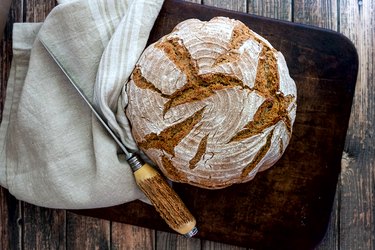
Like a bowl of soup on a rainy day or ice cream in the summer, freshly baked bread is a comforting recipe you can enjoy at any time of the year (or day). The ingredients are fairly simple and you can even make bread without bread flour.
Although bread flour will give you that good chewy texture, it's definitely not a must-have when it comes to baking bread.
Video of the Day
Video of the Day
Instead, you can stock up on all-purpose flour and a small bag of vital wheat gluten. When combined, these ingredients make the perfect bread flour substitute. Plus, they'll allow you to save up your precious pantry real estate.
All-Purpose Flour vs. Bread Flour: What's the Difference?
As if the science of baking weren't confusing enough, all-purpose flour and bread flour aren't actually the same thing. The main difference between the two lies in the protein content, says Shena Jaramillo, RD.
Bread flour is generally higher in protein and produces more gluten, she says. A type of protein found in wheat, rye and barley, gluten helps give dough more elasticity and it helps foods keep their shape and texture, according to the Celiac Disease Foundation.
Bread flours generally have about 2 percent more protein than most all-purpose flour varieties, Jaramillo says. So, when you use bread flour, the elasticity of the dough increases as you knead, thanks to the gluten. The gluten will not only help the bread keep its shape but will give a crisp feel to the final product.
"A bread flour will create a chewier texture in breads due to increased gluten production," Jaramillo says. "Bread flour can actually also be used for pizza dough and other non-bread items to create the chewier consistency."
Aside from the differences in protein content, all-purpose flour and bread flour are generally the same when it comes to nutritional composition.
Buy Flour
How to Convert All-Purpose Flour to Bread Flour
There are no set rules when it comes to converting all-purpose flour to bread flour — all-purpose flour can be used in place of bread flour with exactly the same measurements, Jaramillo says. But you may notice some textural differences when your bread is baked.
To recreate the chewiness you usually get with bread flour, Jaramillo recommends using a product called vital wheat protein or vital wheat gluten ($7, Amazon). Essentially, this product is the same protein you find in bread flour but isolated.
You can evenly swap all-purpose flour for bread flour recipes, but, the texture of your bread may be less chewy. Depending on your desired texture, you can add more or less wheat protein to the dough.
Tip
Add 1 to 2 tablespoons of vital wheat gluten per cup of all-purpose flour to re-create the texture of standard bread flour.